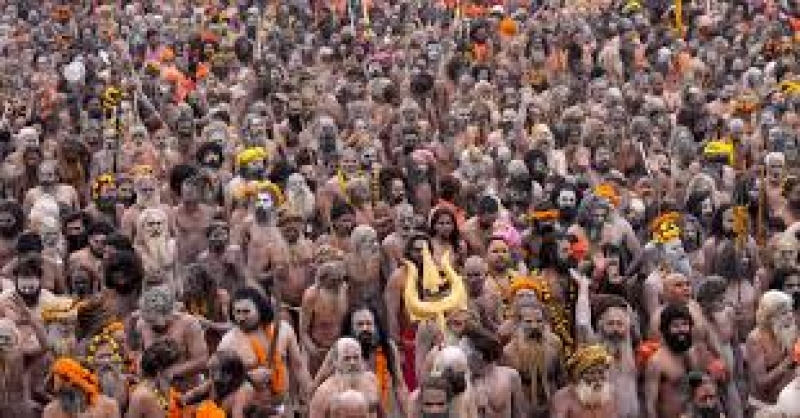- US Issues Travel Alert for Bangladesh Ahead of Election |
- Air ambulance carrying bullet-hit Hadi flies for Singapore |
- Can Dhaka’s arms recovery drive ensure peaceful polls? |
- ‘Unhealthy’ air quality recorded in Dhaka Monday morning |
- BD peacekeepers' deaths: UN chief calls Dr. Yunus, offers condolence |
Millions of Pilgrims Take Holy Dips at India’s Maha Kumbh Festival

Tens of thousands of naked Hindu ascetics and millions of pilgrims immersed themselves in freezing waters at the confluence of three sacred rivers in northern India on Tuesday, marking the first of many ritual baths at the Maha Kumbh festival, the world’s largest religious gathering.
Clad in only sacred ash, holding tridents, swords, spears, and small two-headed drums, these holy men — with matted dreadlocks and garlands of marigolds — made their way to the confluence of the Ganges, Yamuna, and the mythical Saraswati rivers in Prayagraj. They chanted devotional hymns dedicated to Lord Shiva as they marched in a grand procession, accompanied by music, singing, and the rhythmic sounds of horns.
As dawn broke, millions of devoted pilgrims followed them to the riverbanks, where they too took part in the sacred dips, believed to cleanse them of sins and release them from the cycle of rebirth.
The Maha Kumbh festival, held once every 12 years, began on Monday. According to officials, more than 15 million people bathed in the holy rivers on the first day. Over the course of the next six weeks, the festival is expected to draw over 400 million attendees, who will engage in various rituals and ceremonies.
Among those in the river on Tuesday was Venkatesh Ramaling, a tech specialist from Pune. “It’s amazing to see so many people diving into such cold water,” he said, visibly moved. “The faith here is so strong, and seeing this dedication fills me with inspiration. After my bath, I feel full of positivity.”
The festival is steeped in Hindu mythology, with origins tracing back to the story of the god Vishnu who wrested a golden pitcher containing the nectar of immortality from demons. Legend says that a few drops of this nectar fell at Prayagraj, along with three other cities — Nasik, Ujjain, and Haridwar — where the Kumbh festival is celebrated in rotation.
This year’s gathering is the grandest in history, attracting both devout Hindus and visitors from around the world. Authorities have invested over $765 million to build a vast temporary city on the riverbanks, designed to accommodate pilgrims, holy men, and tourists. The setup includes 3,000 kitchens, 150,000 toilets, and 50,000 security personnel to ensure safety and efficient crowd management.
“It’s a powerful display of spiritual unity,” said Stephen Barker, a New York-based artist attending the festival. “There’s something deeply fascinating about seeing so many people gathered with one shared purpose.”
In order to manage the immense crowds, authorities have deployed cutting-edge surveillance technology. Senior police official Rajnish Diwedi reported that more than 2,700 cameras, some equipped with AI, are monitoring crowd movement. Central control rooms are able to deploy security personnel quickly in response to potential risks.
The riverbanks are lined with camps set up by groups of Hindu ascetics known as Naga Sadhus, who have long been revered for their devotion to Lord Shiva. These ascetics — once mercenary warriors — are key figures in the festival, leading religious discourses and guiding devotees in prayer.
Sri Digambar Ishwargiri, a Naga Sadhu from Junagadh, nearly 1,600 kilometers away, described the river dips as a step toward salvation. “This is the sacred ground for liberation,” he explained while sitting cross-legged next to a ceremonial fire and trident. “We are the protectors of Hinduism, safeguarding its faith.”
While bathing occurs daily, the most auspicious days draw tens of thousands of ascetics and pilgrims, charging to the holy rivers at dawn. Many devotees stay for the entire festival, practicing austerity, offering alms, and bathing at sunrise each day. The event is marked by a constant rhythm of prayer, meditation, and yoga — deeply rooted in the spiritual traditions of Hinduism.
The Maha Kumbh festival stands as a remarkable testament to devotion, community, and the enduring power of faith.

